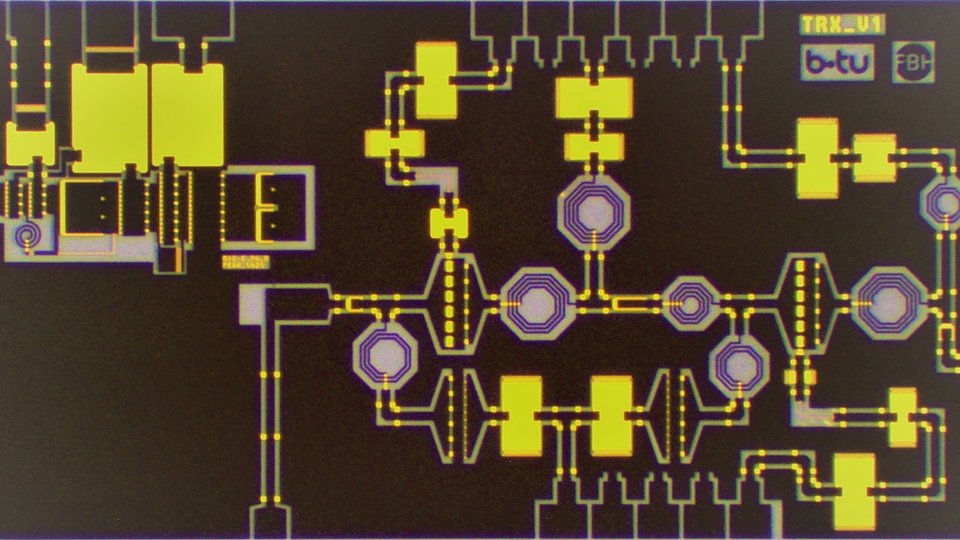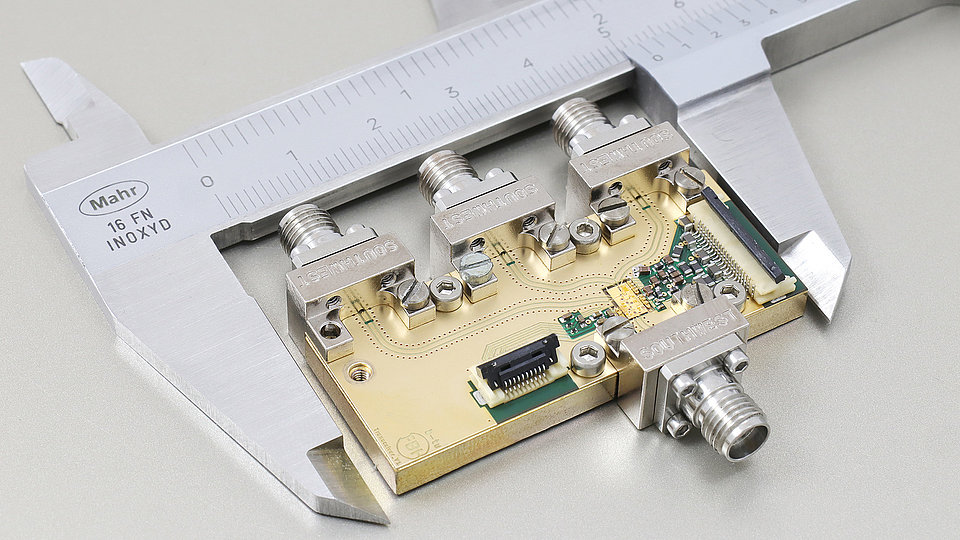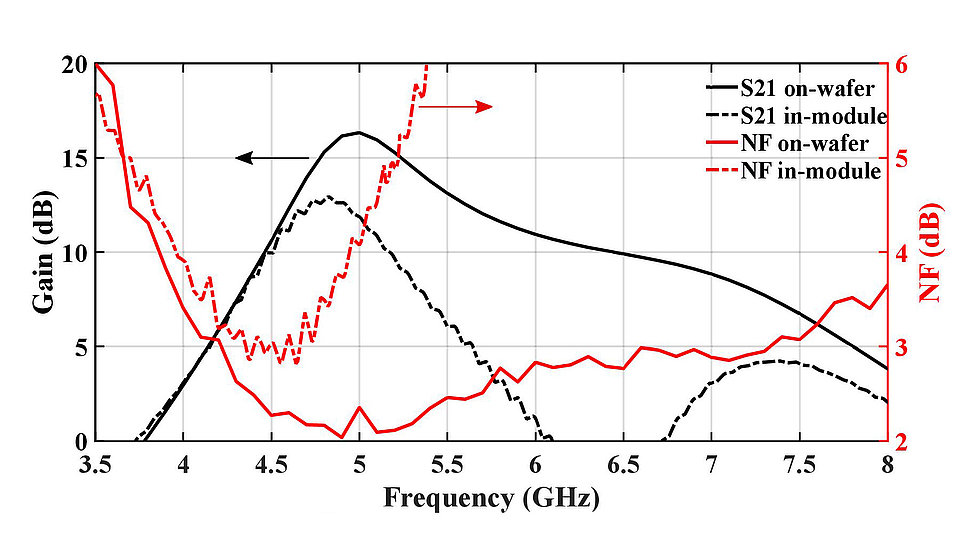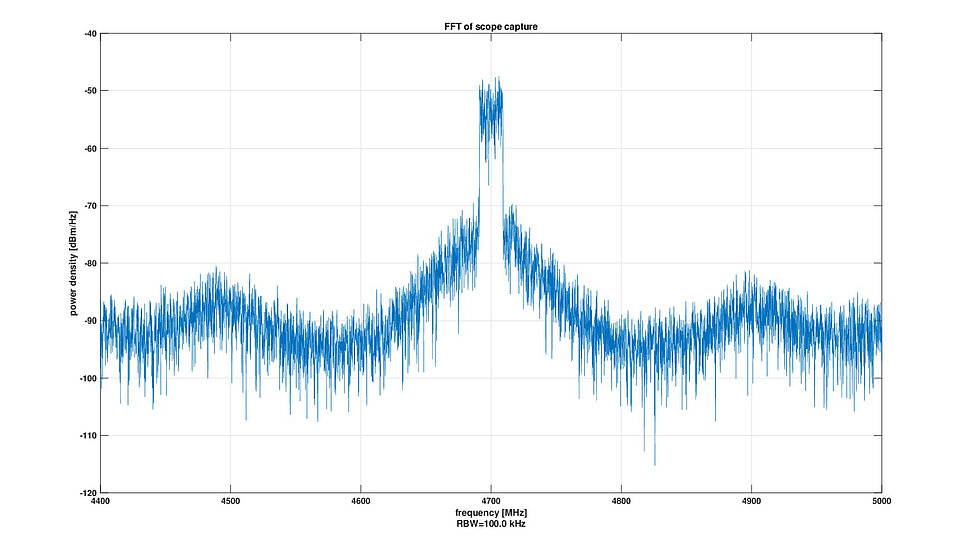Digital GaN-based transceiver module for future green 5G networks
Fig. 3. Gain and noise figure of the LNA measured: on-wafer (solid) and coaxially in-module (dotted).
The demand for advanced RF T/R front-end modules is growing quickly in fields like space applications, 5G communications, and radar technology. These essential components, key for next-gen networks, combine wideband, power, and low noise to tackle modern tech challenges. Recent innovations have produced compact single-chip half-duplex transceivers at 5 GHz, integrating a low noise amplifier, switch, and power amplifier. While these MMICs represent significant progress in miniaturization, the underlying concept remains rather conservative.
Hence, we present an innovative digital transceiver concept that combines an LNA with integrated switching functionality (LNAiS). The module is complemented by a true digital class-E power amplifier using FBH’s GaN technology. At the antenna port, PA output and LNAiS input are connected in parallel, as a separate switch is not required to isolate the Rx and Tx paths. To minimize the mutual detuning of PA and LNA at the antenna port, an optimized common matching is designed.
This concept also marks the first integration of a highly flexible, compact, and efficient digital PA on a TRx chip to date. Due to the digital nature of the PA, the Tx can serve a wide bandwidth from the kHz range to 6 GHz by switching between frequency bands. This is achieved simply by changing the input signal and slightly adjusting the (broadband) output network. One only has to change in Rx mode to another LNA for the respective band. This approach replaces several narrowband conventional analog PA modules, which saves a significant amount of energy and paves the way for a greener ICT.
The LNAiS and digital PA are integrated into a single compact chip (see Fig. 1). The two circuits are connected through the final-stage output inductance of the PA and realized in a hybrid transceiver module as depicted in Fig. 2. In Rx mode, the LNA shows a low noise figure of 3 dB (2.17 dB on-wafer) and a good gain of almost 13 dB (14 dB on-wafer) at the targeted frequency of 4.7 GHz. In Tx mode, the LNAiS provides a high isolation of > 20 dB. The flexible digital class-E PA shows efficiencies of 46 % for 20 MHz LTE (6.5 dB PAPR) and 25 % for OFDM (9 dB PAPR) input signals at 4.7 GHz, respectively. Furthermore, the PA achieves a maximum Pout of 32 dBm at a drain supply voltage of 12 V for 1-tone input with 50 % duty-cycle. Moreover, 37 % of ηdrain has been achieved at 3.7 GHz with a 6.5 dB 20 MHz LTE signal, proving the flexibility of the digital approach, only limited by the class-E-like output network in this work. In terms of linearity, the values need improvement for practical applications. However, the proposed novel digital TRx combines promising performance with high flexibility in the Tx chain and compacter circuitry, since an antenna switch is no longer required. The concept therefore proves to be a true candidate to realize a greener ICT in future 5G networks.
This work was funded by the Deutsche Forschungsgemeinschaft (DFG) under grant no. WE6288/3-1 and RU1203/17-1. Further, it was partly funded by the German Federal Ministry of Education and Research (BMBF) within the "Research Fab Microelectronics Germany (FMD)" framework under ref. 16FMD02, as well as within the project "GreenICT@FMD" under ref. 16ME0505.
Publication
M. Krishnaji Rao, A. Wentzel, T. Hoffmann, L. Schellhase, S. A. Chevtchenko, and M. Rudolph, „Digital GaN-based Transceiver Module for Future Green 5G Networks”, European Microwave Conference 2024 (accepted for publication).



